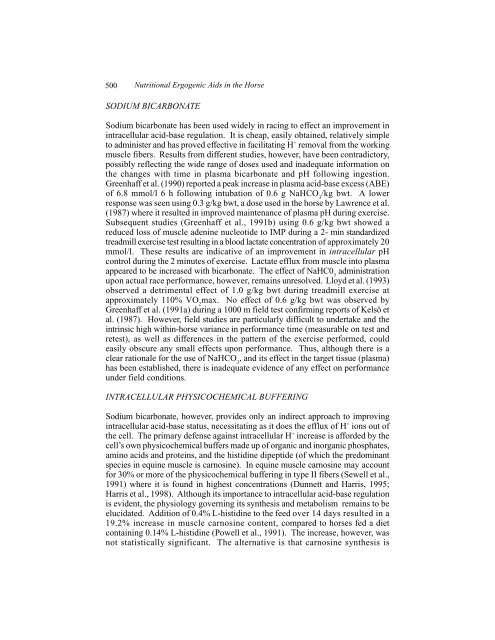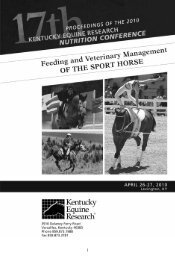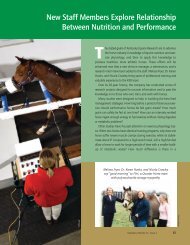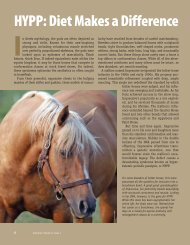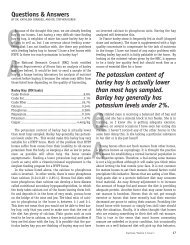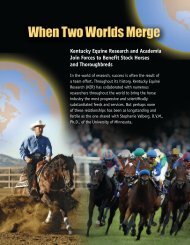Nutritional Ergogenic Aids in the Horse - Kentucky Equine Research
Nutritional Ergogenic Aids in the Horse - Kentucky Equine Research
Nutritional Ergogenic Aids in the Horse - Kentucky Equine Research
- No tags were found...
Create successful ePaper yourself
Turn your PDF publications into a flip-book with our unique Google optimized e-Paper software.
500 <strong>Nutritional</strong> <strong>Ergogenic</strong> <strong>Aids</strong> <strong>in</strong> <strong>the</strong> <strong>Horse</strong>SODIUM BICARBONATESodium bicarbonate has been used widely <strong>in</strong> rac<strong>in</strong>g to effect an improvement <strong>in</strong><strong>in</strong>tracellular acid-base regulation. It is cheap, easily obta<strong>in</strong>ed, relatively simpleto adm<strong>in</strong>ister and has proved effective <strong>in</strong> facilitat<strong>in</strong>g H + removal from <strong>the</strong> work<strong>in</strong>gmuscle fibers. Results from different studies, however, have been contradictory,possibly reflect<strong>in</strong>g <strong>the</strong> wide range of doses used and <strong>in</strong>adequate <strong>in</strong>formation on<strong>the</strong> changes with time <strong>in</strong> plasma bicarbonate and pH follow<strong>in</strong>g <strong>in</strong>gestion.Greenhaff et al. (1990) reported a peak <strong>in</strong>crease <strong>in</strong> plasma acid-base excess (ABE)of 6.8 mmol/l 6 h follow<strong>in</strong>g <strong>in</strong>tubation of 0.6 g NaHCO 3/kg bwt. A lowerresponse was seen us<strong>in</strong>g 0.3 g/kg bwt, a dose used <strong>in</strong> <strong>the</strong> horse by Lawrence et al.(1987) where it resulted <strong>in</strong> improved ma<strong>in</strong>tenance of plasma pH dur<strong>in</strong>g exercise.Subsequent studies (Greenhaff et al., 1991b) us<strong>in</strong>g 0.6 g/kg bwt showed areduced loss of muscle aden<strong>in</strong>e nucleotide to IMP dur<strong>in</strong>g a 2- m<strong>in</strong> standardizedtreadmill exercise test result<strong>in</strong>g <strong>in</strong> a blood lactate concentration of approximately 20mmol/l. These results are <strong>in</strong>dicative of an improvement <strong>in</strong> <strong>in</strong>tracellular pHcontrol dur<strong>in</strong>g <strong>the</strong> 2 m<strong>in</strong>utes of exercise. Lactate efflux from muscle <strong>in</strong>to plasmaappeared to be <strong>in</strong>creased with bicarbonate. The effect of NaHC0 3adm<strong>in</strong>istrationupon actual race performance, however, rema<strong>in</strong>s unresolved. Lloyd et al. (1993)observed a detrimental effect of 1.0 g/kg bwt dur<strong>in</strong>g treadmill exercise atapproximately 110% VO 2max. No effect of 0.6 g/kg bwt was observed byGreenhaff et al. (1991a) dur<strong>in</strong>g a 1000 m field test confirm<strong>in</strong>g reports of Kelsö etal. (1987). However, field studies are particularly difficult to undertake and <strong>the</strong><strong>in</strong>tr<strong>in</strong>sic high with<strong>in</strong>-horse variance <strong>in</strong> performance time (measurable on test andretest), as well as differences <strong>in</strong> <strong>the</strong> pattern of <strong>the</strong> exercise performed, couldeasily obscure any small effects upon performance. Thus, although <strong>the</strong>re is aclear rationale for <strong>the</strong> use of NaHCO 3, and its effect <strong>in</strong> <strong>the</strong> target tissue (plasma)has been established, <strong>the</strong>re is <strong>in</strong>adequate evidence of any effect on performanceunder field conditions.INTRACELLULAR PHYSICOCHEMICAL BUFFERINGSodium bicarbonate, however, provides only an <strong>in</strong>direct approach to improv<strong>in</strong>g<strong>in</strong>tracellular acid-base status, necessitat<strong>in</strong>g as it does <strong>the</strong> efflux of H + ions out of<strong>the</strong> cell. The primary defense aga<strong>in</strong>st <strong>in</strong>tracellular H + <strong>in</strong>crease is afforded by <strong>the</strong>cell’s own physicochemical buffers made up of organic and <strong>in</strong>organic phosphates,am<strong>in</strong>o acids and prote<strong>in</strong>s, and <strong>the</strong> histid<strong>in</strong>e dipeptide (of which <strong>the</strong> predom<strong>in</strong>antspecies <strong>in</strong> equ<strong>in</strong>e muscle is carnos<strong>in</strong>e). In equ<strong>in</strong>e muscle carnos<strong>in</strong>e may accountfor 30% or more of <strong>the</strong> physicochemical buffer<strong>in</strong>g <strong>in</strong> type II fibers (Sewell et al.,1991) where it is found <strong>in</strong> highest concentrations (Dunnett and Harris, 1995;Harris et al., 1998). Although its importance to <strong>in</strong>tracellular acid-base regulationis evident, <strong>the</strong> physiology govern<strong>in</strong>g its syn<strong>the</strong>sis and metabolism rema<strong>in</strong>s to beelucidated. Addition of 0.4% L-histid<strong>in</strong>e to <strong>the</strong> feed over 14 days resulted <strong>in</strong> a19.2% <strong>in</strong>crease <strong>in</strong> muscle carnos<strong>in</strong>e content, compared to horses fed a dietconta<strong>in</strong><strong>in</strong>g 0.14% L-histid<strong>in</strong>e (Powell et al., 1991). The <strong>in</strong>crease, however, wasnot statistically significant. The alternative is that carnos<strong>in</strong>e syn<strong>the</strong>sis is


